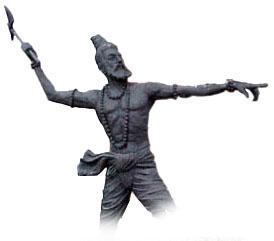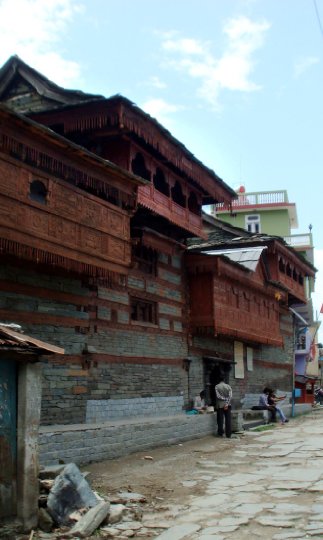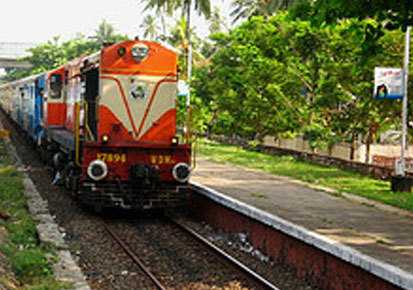According to popular myth, Kerala was created when Parasurama, the sixth incarnation of Vishnu, threw his axe from Kanyakumari to Gokarnam. The sea moved away along the trajectory of the axe, and a fertile strip of land came out.
 I located a book (പരശുരാമൻ: ഒരു പഠനം – “Parasurama: A Study”) on Parasurama at the Kerala Sahitya Akademi bookstore this December. It was a serendipitous find! I never knew such an in-depth study existed.
I located a book (പരശുരാമൻ: ഒരു പഠനം – “Parasurama: A Study”) on Parasurama at the Kerala Sahitya Akademi bookstore this December. It was a serendipitous find! I never knew such an in-depth study existed.
This book explores the myths and legends about this enigmatic mythical figure. It’s a fascinating read.
———————-
Kerala has a way of taking Indian myth and making it local (I suppose all parts of India do this). Accordingly, the powerful Asura king Mahabali, who conquered all three worlds (heaven, earth and the nether regions) becomes the benevolent potbellied Maveli, erstwhile ruler of Kerala who bears surprising resemblances to aboriginal fertility gods: similarly Parasurama (“Rama with an axe”) becomes the creator of the region.
According to Hindu myth, Parasurama, the sixth incarnation of Vishnu, was a Brahmin who behaved more like a warrior: he is mainly known for the mass annihilation of Kshatriya kings, as he traversed the world 21 times. His animosity towards Kshatriyas was born when his father, the sage Jamadagni, was murdered by the kin of King Karthaveeryarjuna. After the genocide, the repentant Parasurama forsook his axe, donated all the captured lands to Brahmins and is currently spending his days in meditation (Sanyasa) – there is no death for him, as he is an immortal.
Parasurama also has the dubious distinction of murdering his mother at his father’s behest. Renuka, Jamadagni’s wife, supposedly was attracted to a Gandharva and therefore guilty of adultery (though only in spirit). Her husband, however, was adamant that she should be killed – among his sons, only Parasurama agreed to do it. The happy sage granted his son whatever boon he wished – and he promptly asked that his mother be restored to life, which was granted.
The above stories illustrate why my mother was wary of telling me stories of Parasurama as a kid. My father belongs to the Royal Family of Cochin (being matrilineal, I don’t, but that’s not relevant here) and my mother apparently did not want her son to grow up hearing stories praising the sworn enemy of her husband’s family. And more obviously, she was highly disturbed by the episode of matricide.
Obviously, Parasurama is an icon of Vedic Brahmanism, and recounts the mythologised history (to a certain extent, at least) of the victory of clergy over royalty. And the story of him killing his mother might be taken as a metaphorical statement of the matriarchal societies of the Indian subcontinent being subdued by the patriarchal Aryans.
However, Parasurama is linked by folklore to many parts of India, most notably the Western Coast and Himachal Pradesh. This fascinating book explores these stories, and try to formulate an image of this bloodthirsty sage, both mythical as well as historical.
Himachal Pradesh and the North

It is in the hilly state of Himachal Pradesh, it seems, that Parasurama is most revered. The locals believe that he was born there, lived there and is still meditating somewhere in the hills. In Nirmand, a village 150 km northeast of Shimla (the state capital) on a hill, is where the famous “Parasurama Kothi” is located. This is a sacred room housing a sacred urn filled with water, which is supposed to represent Parasurama. It also houses a three-faced idol, the face of the sage flanked by “Kala” (Time) and “Kama” (Desire). It is the belief that Parasurama is meditating somewhere inside the Kothi: every twelve years, the “Bhunda” ceremony is carried out with much fanfare.
Legends tell of Parasurama coming here after the death of his parents and meditating for 12 years; and finding no Brahmins to do sacrifices, bringing them from elsewhere and settling them there. There are also stories of the antagonism between the immigrants and the locals, and the assignment of other castes to do the service of Brahmins. These, I found as I moved through the book, is a common theme of the Parasurama legends.
There are also folkloric myths about this sage in Kashmir, Assam and Arunachal Pradesh.
The West Coast, Konkan, Goa and Karnataka
The legends on the west coast regarding Parasurama have mostly the following in common:
1. Parasurama donated the land taken from Kshatriyas to Brahmins.
2. He was instrumental in reclaiming land from the sea in various places.
3. Whenever there were no Brahmins available, he elevated the locals to Brahmins (in some cases, even rejuvenating corpses and bones).
4. Many Brahmins lost their status later due to Parasurama’s curse.
The stories reveal an aggressive proselytizer. One could almost say that this was the history of the Aryan migration to the West Coast – but the “Brahminisation” of locals smacks more of a give-and-take affair. Also, in most cases, Parasurama is said to have been abetted by local kings: In contrast to his enmity towards Kshatriyas as mentioned in the Puranas, here we find a man who is hand-in-glove with the local aristocracy.
(A curious fact: Parasurama’s mother Renuka is linked with many Dravidian mother goddesses of South India. Was she the icon of a mother cult which was subjugated by Brahminism? The metaphorical beheading and the subsequent reincarnation seem to point to this.
 Another interesting piece of information is Renuka’s identification with Yellamma, a goddess of Karnataka who is now known as a patron of Devadasis, the traditional temple courtesan’s of India. But it seems that Yellamma was originally a goddess for women who wanted freedom from their abusive husbands, and also for those who wanted to live their lives as they liked, without being tied to domesticity. Another example of patriarchal subversion?)
Another interesting piece of information is Renuka’s identification with Yellamma, a goddess of Karnataka who is now known as a patron of Devadasis, the traditional temple courtesan’s of India. But it seems that Yellamma was originally a goddess for women who wanted freedom from their abusive husbands, and also for those who wanted to live their lives as they liked, without being tied to domesticity. Another example of patriarchal subversion?)
Kerala
Kerala is where Parasurama is really special – because he is supposed to be the creator of the region, and of donating it to Brahmins. According to the local version of the myth, Parasurama threw his axe in disgust from Kanyakumari in the southernmost tip of India to Gokarnam in the north. The sea withdrew from the areas traversed by the axe, and threw up the state of Kerala. The whole area was donated to Brahmins by the sage.
The intricate and peculiar caste system of Kerala Brahmins – the Namputhiris – is partially ascribed to Parasurama through the book Bhargava Smrithi, purportedly condensed by Jagad Guru Adi Sankara as Sankara Smrithi. What is curious is that there is a caste hierarchy within the Brahmins themselves, which is detailed out in another book, again by the sage! Surprisingly, however, there are very few temples dedicated to the sage in this state – the only famous one is the temple at Thiruvallam.
(There is a curious fact I remember from childhood. Parasurama sits in one corner of the famous Vadakkunnatha Temple, dedicated to Siva, at Thrissur. When we used to visit the temple, my father never used to worship there – being a Kshatriya, he was forbidden! Due tour matrilineal system, my mother and I could, because we were technically non-Kshatriyas. Old enmities die hard!)
Conclusion
Parasurama has many facets: the warrior Brahmin, the proselytizer, the yogi and even as creator (in Himachal Pradesh). However, this incarnation of Vishnu remains strangely mysterious, compared to the more famous Rama and Krishna.
I have given only a brief overview of the depth and breadth the Parasurama myths explored in this slim volume. It is an excellent introduction to the subject and has left me gasping for more. I would recommend it to anyone who can read Malayalam. (Being a publication by the Sahitya Akademi, it could get translated at some point of time – but don’t hold your breath.)
———————-
PS: Parasurama is perhaps the only deity in the world who has a train named after him. The Parasuram Express runs from Thiruvananthapuram to Mangalore, tracing the path supposedly taken by Parasurama’s axe.

It seems to be a very fascinating book; and the essence of it has been so succinctly captured in your introduction. Thank you. Will be on the look out.
Sahitya Akademi has a lot of fascinating books like this. Unfortunately, their marketing is very poor.
Thanks for reading!
It is always a pleasure to read your well written intros and reviews. And yes I know, the Sahitya Akademi’s (and its cousins too) marketing is zilch. On a past visit to Trivandrum, with great difficulty I could locate the Kerala Bhasha Institute. 🙂
If you ever visit Thrissur, pay a visit to the Akademi bookstore. It’s within 2 km of my house. 🙂
who is the author of this article